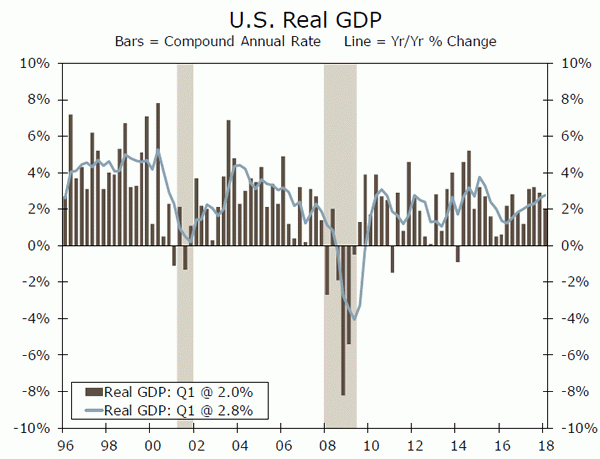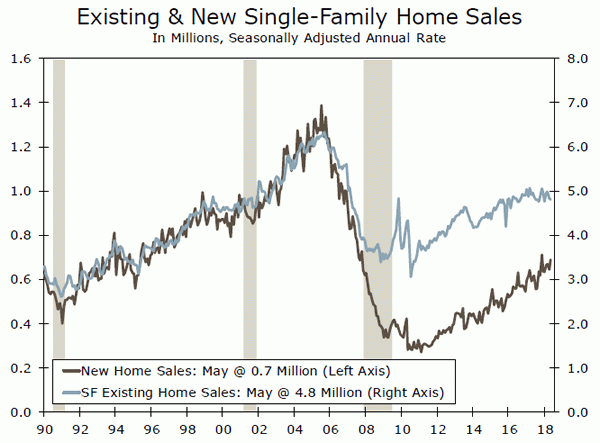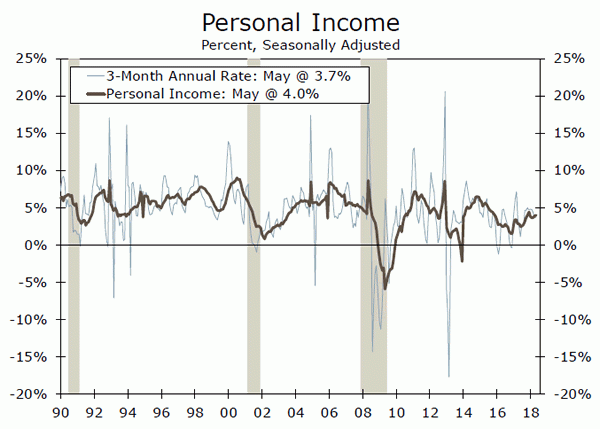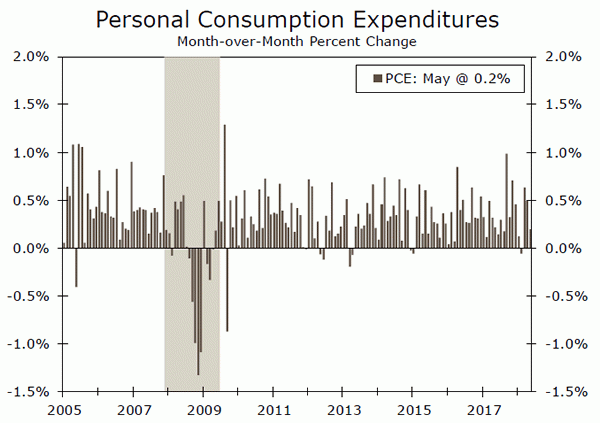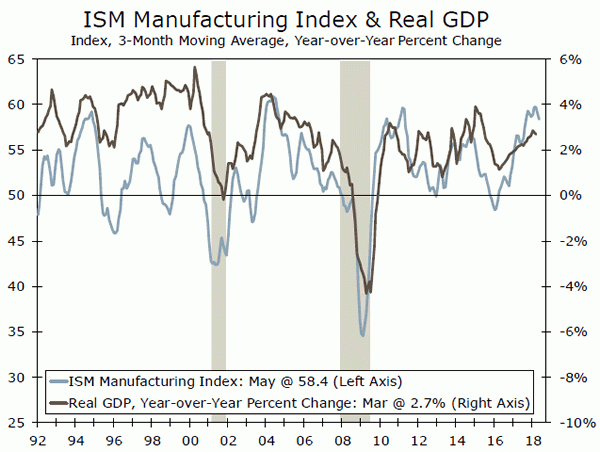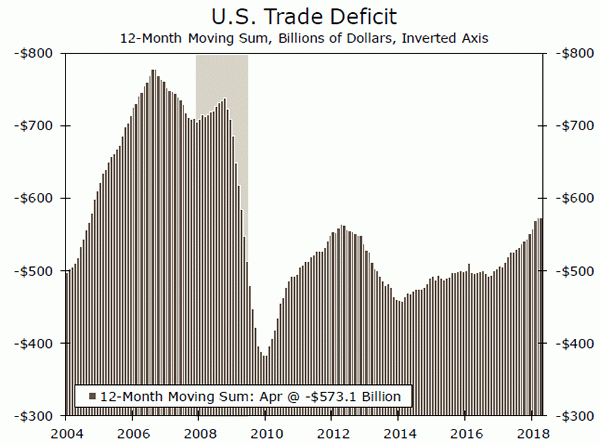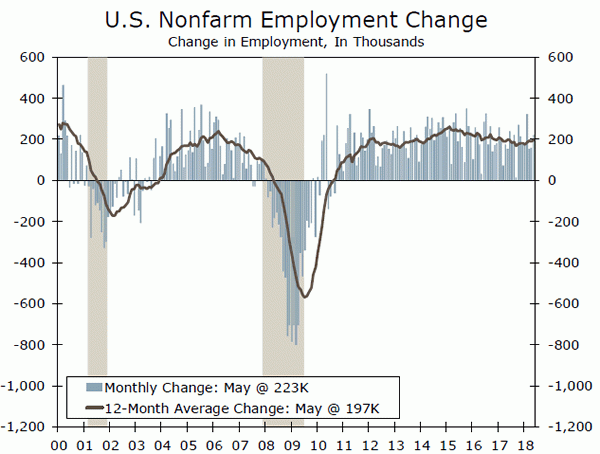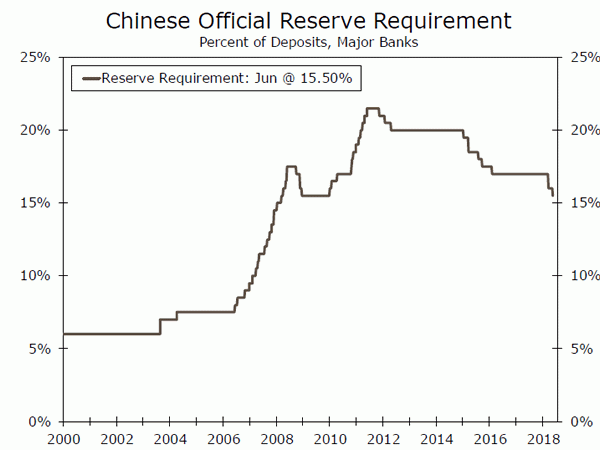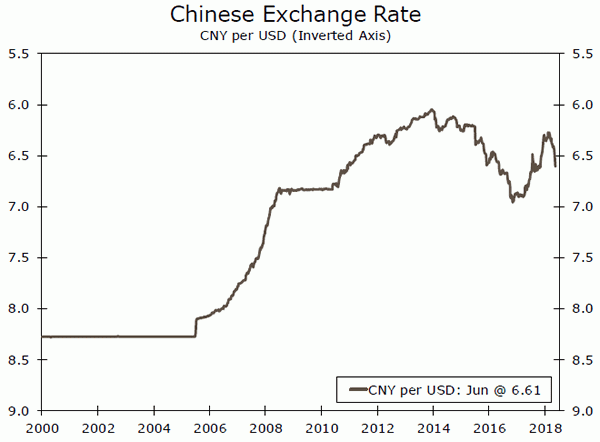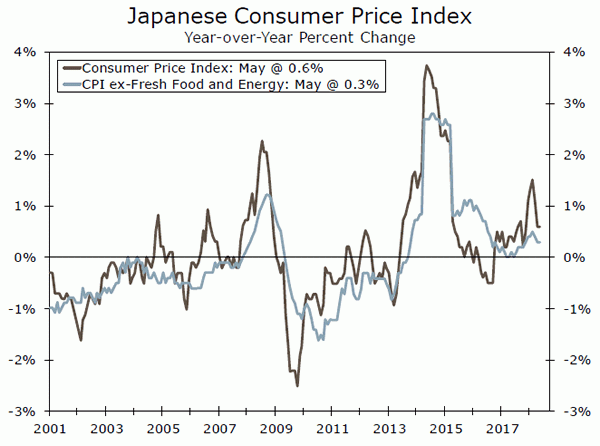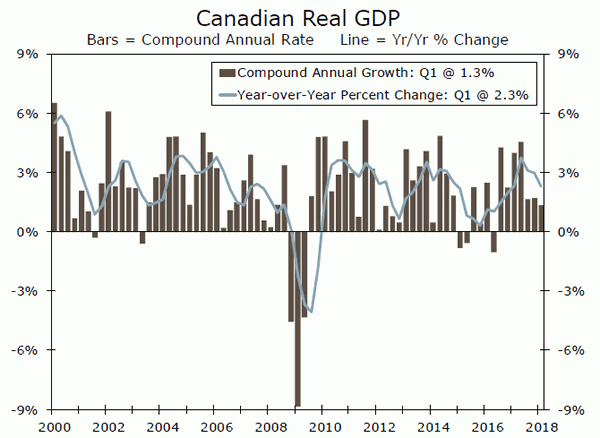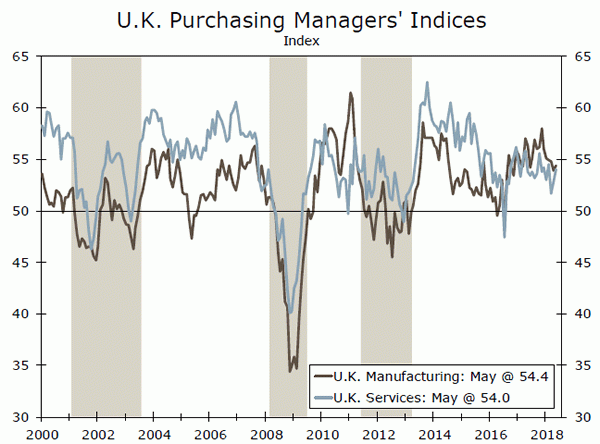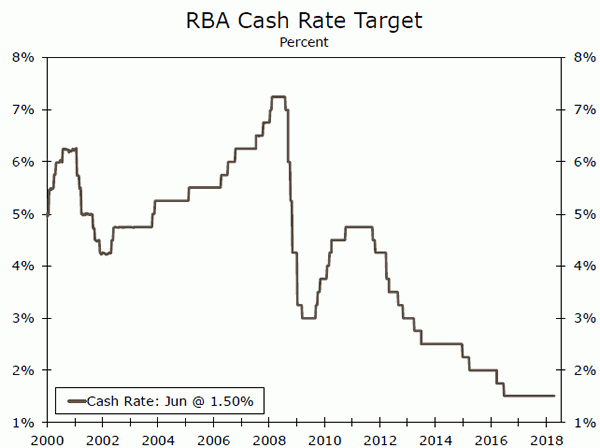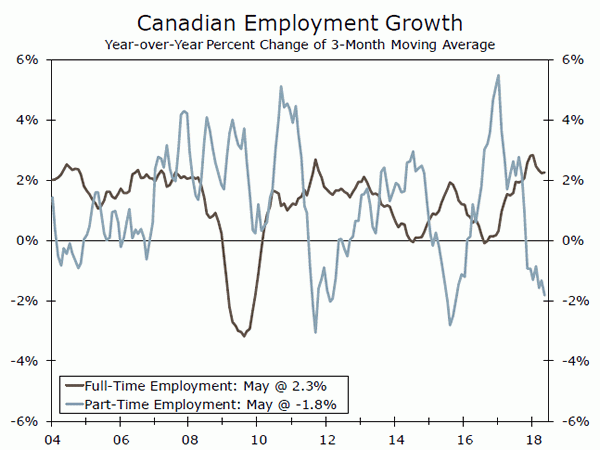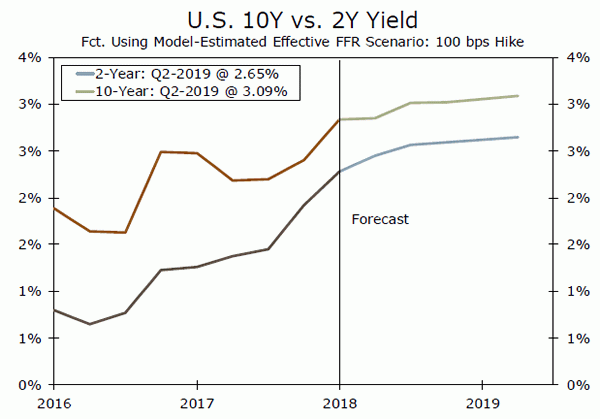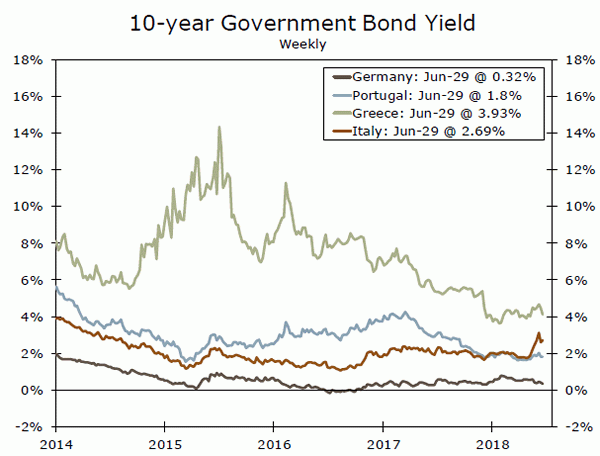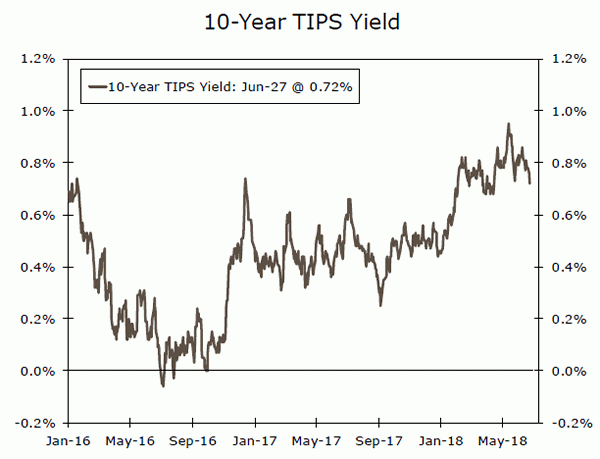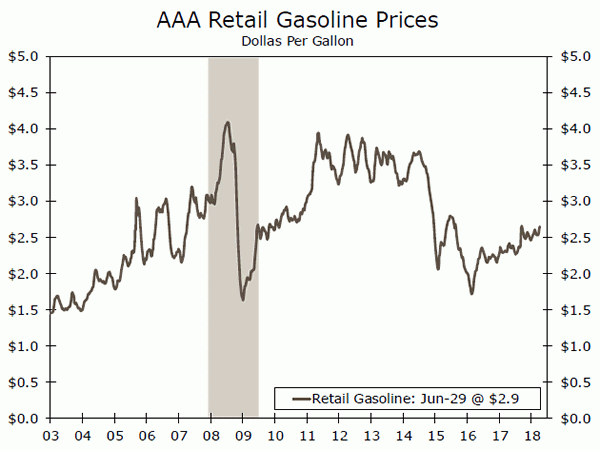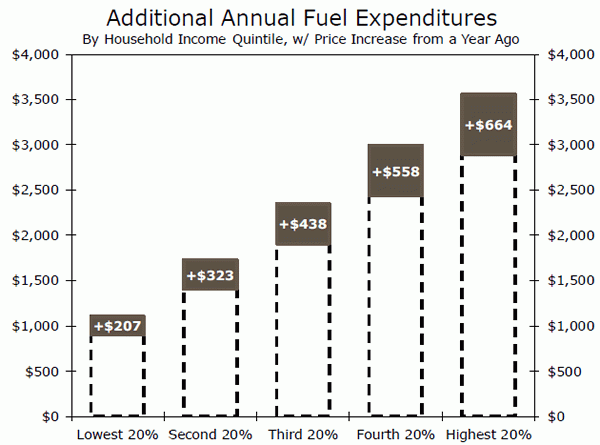U.S. Review
GDP Growth Revised Lower But Poised for Rebound
- New home sales jumped 6.7 percent in May, though April was revised lower. Tight inventories continue to push up prices and limit home sales. The S&P CoreLogic Case-Shiller National Home Price Index increased 0.3 percent in April.
- First-quarter gross domestic product (GDP) growth was revised down to 2.0 percent, from 2.2 percent prior. However, we expect GDP growth in Q2 to rebound to 4.5 percent.
- Personal income growth rose 0.4 percent in May, up from 0.3 percent in April. Spending growth was weaker than expected, at 0.2 percent, and April’s gain was revised down.
GDP Growth Revised Lower But Poised for Rebound
New home sales jumped 6.7 percent in May, to a 689,000-unit pace. However, April sales were revised lower and now reflect a 3.7 percent drop. Sales in the South were up 17.9 percent in May, to a new cycle high, and accounted for all of the national increase. More than half of new home sales occur in the South, so fluctuations in this region have a large impact on the total.
We have repeatedly written about lack of inventories restricting sales in the markets for new and existing homes. This remains true, but new home construction looks to be picking up, especially in the South where land is more readily available for development. Building activity looks to be back on track in the region after disruptions from hurricanes Harvey and Irma.
The current mismatch between supply and demand of housing has contributed to strong price gains. The S&P CoreLogic Case-Shiller National Home Price Index increased 0.3 percent in April, a 6.4 percent gain year-over-year. Price increases are widespread, with 17 markets in the 20-city index showing higher prices in April. Average prices for new homes fell in May, but this reflected compositional changes—more entry-level sales and more sales in the South (where homes are less expensive)—rather than underlying weakening.
Consumer confidence dropped 2.4 points in June to 126.4, but remains at a high level. The largest portion of the dip in confidence came from consumer expectations, which were likely dampened by ongoing trade disputes and higher gasoline prices. Nevertheless, more than twice as many consumers expect business conditions to improve over the next six months than expect them to worsen. Optimism about the labor market eased somewhat, but remained consistent with continued gains in nonfarm payrolls. We expect some slowing in job growth as open positions become harder to fill in a tighter labor market, but for the upward trajectory in nonfarm payrolls to remain intact.
First-quarter GDP growth was revised down to 2.0 percent in the third estimate, from 2.2 percent prior. The revision is due to slower consumer spending growth and smaller inventory accumulation than the government had previously estimated. This means first-quarter GDP growth was much softer than the previous three quarters, which averaged 3.1 percent. However, Q1 GDP has come in weaker in the last several years, suggesting that seasonal factors are partly to blame. We expect a strong rebound in the second quarter, to 4.5 percent annualized growth. The magnitude of this quarterly gain is influenced by low base effects from Q1, but we expect robust growth to continue through 2018. A strong labor market and tax cuts should remain supportive of GDP.
Personal income grew 0.4 percent in May, up from 0.2 percent the month prior. Personal spending slowed to 0.2 percent growth, and April’s gain was revised down 0.1 percentage point to 0.5 percent. Given solid income and employment growth and continued strength in consumer confidence, we expect consumption to pick back up. Even with some slowing, consumption should be much more supportive of GDP growth in Q2 versus Q1.
U.S. Outlook
ISM Manufacturing • Monday
The manufacturing sector continued to report higher levels of activity in May. The ISM headline print of 58.7 beat expectations, with most of the subcomponents moving further into expansion territory. The new orders component increased 2.5 points to 63.7. Meanwhile, new export orders fell 2.1 points and imports declined 3.7 points, in possible signs of a dimming trade outlook. The prices paid measure also rose to a seven-year high of 79.5.
While the ISM in May exceeded consensus estimates, there continues to be a divergence between the “soft” survey data and the “hard” data such as output and new orders. In prior periods, consistent readings of 55 or higher from the ISM would indicate stronger GDP growth and robust manufacturing activity. However, the ISM has been running well ahead of the growth in new orders, raising questions about when the survey responses of increased activity will be corroborated in the hard data.
Previous: 58.7 Wells Fargo: 58.3 Consensus: 58.3
Trade Balance • Friday
The trade deficit narrowed for the second consecutive month in April, as exports increased 0.3 percent while imports declined 0.2 percent. Imports of both iron and steel mill products and bauxite and aluminum products have increased year-to-date in April compared to last year. However, April’s report is not yet capturing the broader extension of steel and aluminum tariffs on Europe and NAFTA trading partners, which go into effect in June.
It remains unclear the extent to which tariffs will impact current trade dynamics; however, there has been a noticeable softening in both the import and export components of the ISM survey data over the past three months, a possible warning of a slowdown in trade. However, given the shrinking deficit in both March and April, trade is currently poised to have a substantial positive impact on GDP growth in the second quarter.
Previous: -$46.2B Wells Fargo: -$43.9B Consensus: -$43.8B
Employment • Friday
The labor market improved across the board in May. Employers beat expectations and added 223,000 new jobs. Payroll growth also continued to broaden as the net share of industries adding jobs improved to 67.6 in May. Strong hiring over the past few months also helped push the unemployment rate down to 3.8 percent, matching the low of the 1991-2001 cycle. Average hourly earnings also increased 0.3 percent in May, improving to 2.7 percent year-to-year rate.
Rising compensation costs should help resolve some of the structural challenges facing the labor force by enticing more workers off the sidelines. Prime-age participation ticked down for the third consecutive month in May. While there has been improvement in recent years, participation among this cohort remains below prerecession levels and a full recovery remains some ways off.
Previous: 223K Wells Fargo: 185K Consensus: 198K
Global Review
Chinese Currency Comes Under Downward Pressure
- The Chinese renminbi has depreciated in recent weeks due to concerns about a potential trade war and steps by the Chinese central bank to provide more liquidity in the banking system. Our currency strategists look for the renminbi to eventually regain its footing against the dollar, but they acknowledge that it could weaken further if trade tensions continue to escalate.
- In Japan, economic data for May suggest that real GDP, which contracted mildly in the first quarter for the first time in more than two years, grew at a modest pace in Q2.
- Data released this week suggest that growth in Canada should be solid in Q2.
Chinese Currency Comes Under Downward Pressure
The Chinese central bank announced early this week that it was cutting the required reserve ratio (RRR) for major banks from 16.00 percent to 15.50 percent (see graph on front page). Interbank lending rates had been creeping higher, and the cut in the RRR will provide the Chinese banking system with more liquidity. The easing of monetary policy comes amid recent data that suggest some deceleration is underway again in the Chinese economy. Not only were growth rates in retail sales and industrial production in May not as robust as most analysts had expected, but investment spending is currently growing at its slowest rate in at least 20 years. We continue to look for the rate of economic growth in China to slow further, although we think that the probability of an outright contraction in the Chinese economy is low.
The easing of monetary policy in China also contributed to a marked decline in the value of the Chinese renminbi, which was already sliding vis-à-vis the U.S. dollar due to mounting concerns about a potential trade war between the United States and China (top graph). Indeed, the renminbi has slipped more than 3 percent against the greenback in the past two weeks, which is a rather sizeable move for the usually stable Chinese currency. Although our currency strategists look for the renminbi to eventually regain its footing against the dollar, they acknowledge that the Chinese currency could weaken further if trade tensions escalate more.
Japan Economy Probably Rebounded in Q2
Real GDP growth in Japan, the world’s third-largest individual economy, turned negative in Q1-2018 for the first time in more than two years. However, data for May that were released this week indicate that GDP growth probably turned positive again in the second quarter. Although industrial production (IP) edged down 0.2 percent in May relative to the previous month, that modest contraction followed three consecutive months of strong gains that left IP in the April-May period 2.0 percent above Q1. The consensus forecast estimates that real GDP grew at an annualized rate of roughly 2 percent in Q2, which would more than reverse the 0.6 percent contraction that occurred in Q1.
The problem in Japan has been, and continues to be, the abnormally low rate of CPI inflation (middle chart). In that regard, there was a bit of good news this week as CPI inflation in Tokyo, which has a high degree of correlation with the nationwide inflation rate, rose from 0.4 percent in May to 0.6 percent in June. That said, until inflation rises to 2 percent on a sustainable basis, which likely will not happen anytime soon, the Bank of Japan will refrain from removing monetary accommodation.
Canadian Economy Has Solid Momentum
Real GDP growth in Canada has downshifted on a sequential basis in recent quarters (bottom chart). However, the 0.1 percent rise in real GDP in April, which comes on the heels of the 0.3 percent increase posted in March, means that the Canadian economy started off Q2 with a fair degree of momentum. The consensus forecast of 2.5 percent growth in Q2 looks reasonable to us.
Global Outlook
U.K. Manufacturing PMI • Monday
After a strong second half of 2017, the manufacturing sector in the United Kingdom cooled in Q1. The Purchasing Managers’ Index (PMI) for manufacturing has fallen to 54.4 from a high of 58.0 in November 2017, and factory sector output rose just 0.2 percent in Q1. The industrial production data for April suggest the weakness carried into Q2. Manufacturing output fell 1.4 percent in April, and construction output declined an even steeper 3.3 percent amid a streak of declines that has stretched to five months.
The May PMI for the manufacturing sector rose 0.5 points to 54.4, halting another streak of five straight monthly declines. Some stabilization in the June PMI, which is released Monday, would be an encouraging sign that a rebound in factory sector activity is in the offing. Given the sluggish pace of growth in the United Kingdom in Q1, a turnaround in manufacturing and Q2 output for the overall economy is key for a potential Bank of England rate hike in August.
Previous: 54.4 Consensus: 54.0
Reserve Bank of Australia • Tuesday
Economic growth in Australia was robust in Q1, rising at a 4.2 percent annualized rate. The strong print was driven by external demand, however, as exports accounted for roughly half of the quarter’s increase in output. Domestic demand was more tepid, as consumer spending grew at a scant 1.4 percent annualized pace and business investment was not much stronger at 2.1 percent.
For policymakers at the Reserve Bank of Australia (RBA), stubbornly low wage growth and housing market/household leverage concerns have prevented the central bank from joining other developed economy central banks that have tightened policy. While we eventually expect the RBA to join in policy normalization, we believe that policymakers will continue to delay tightening until gradual progress in inflation and the labor market translates into higher wages. This would help households deleverage and offset some of the debt servicing costs associated with rising interest rates.
Previous: 1.50% Consensus: 1.50% (Cash Rate Target)
Canada Employment• Friday
Job growth in Canada has been soft through the first half of the year. Total employment is down almost 50,000 from December 2017. The aggregate numbers mask a split between full-time and part-time employment, however, as full-time employment is up about 76,000 jobs while part-time job growth is firmly in negative territory.
Against this backdrop, wage growth in Canada has skyrocketed, reaching its highest year-over-year pace since 2009. Minimum wage increases in some parts of the country have likely played a role in the gains, but a tightening labor market has also driven “solid labor income growth” as the Bank of Canada noted in its last meeting statement. With inflation on target and the labor market generally giving policymakers a green light, we continue to expect two more rate hikes this year from the Bank of Canada. Sustaining the recent momentum in wage growth will be key, as household leverage concerns are a key risk to the Canadian economy.
Previous: -7,500 Consensus: 20,000
Point of View
Interest Rate Watch
Fed Chairman Powell Pursues Neutral—Yet No Inverted Yield Curve
We have estimated the impact on Treasury rates if the Fed pursues an additional 100 bps of tightening through mid-2019 (top chart). We use the effective fed funds rate, as it is more in line with market interest rates. Under this baseline scenario, the two-year rate rises from 2.45 percent to 2.65 percent in Q2-2019. This is consistent with the history that the two-year moves up with the funds rate, but not one-for-one bps. Meanwhile, the 10-year rate rises from 2.85 percent to 3.09 percent.
These results are lower than our published forecast due to the baseline model not accounting for the specific timing and magnitude of rate hikes, which we are able to adjust for in our final forecast. Historically-lower inflation inputs in the baseline model is another factor that results in the baseline output being lower than our published forecast, even with a faster projected pace of tightening. However, the baseline analysis still does not indicate an inverted yield curve even with an additional 100 bps of Fed hikes.
ECB: No Change in Rates Ahead
Recently, the ECB announced the end of its bond purchase program but also pledged that interest rates would remain unchanged for the period ahead into mid-2019. As illustrated in the middle graph, benchmark European yields have remained fairly low since early 2015 with some minor hiccups for Portugal and Italy and more significant issues for Greece. Without ECB bond buying, 10-year yields are expected to move upward in our outlook even as short-term rates remain unchanged, and generate a steeper yield curve in the year ahead.
TIPS and Inflation Expectations
Inflation expectations can be roughly gauged by comparing Treasury yields to TIPS yields (bottom graph). There has been a distinct upward shift in TIPS yields over the past year that is consistent with a rise for inflation-protected yields within the context of higher nominal rates going forward. This would be consistent with our expectation that both real growth and inflation measures drift upward in the year ahead.
Credit Market Insights
Easing Standards, Seeking Growth
Tepid growth in commercial and industrial (C&I) loans has been a frustration for banks, and now appears to be a key concern for regulators. Demand for C&I loans slowed considerably in 2016 as activity in the energy and industrial sectors cooled. Despite the increased levels of business optimism that began in early 2017, we have not seen a convincing rebound in loan growth. In response to firmer business conditions, many banks have eased their terms and standards on C&I loans. This easing may have helped spur loan growth more recently–in March and April–but it has also caught the eye of regulators.
In its spring risk report, the Office of the Currency Comptroller (OCC) highlighted the relaxing of standards as a top risk to the industry. The number of outstanding matters requiring attention (MRAs), which are citations handed out by the OCC, increased 24 percent since the first quarter of 2017. The MRAs specifically related to a bank making exceptions to its typical lending procedure increased 45 percent over the same period.
The most recent look at the sector, the Fed’s June 22 H.8 report on the balance sheet of commercial banks, showed C&I loan growth slowing to a 0.3 percent annualized pace in May. This may be welcomed by regulators, if it is a reflection of more careful lending habits; however, it still could present concern going forward. If the movement away from C&I loans is not a passing trend, but rather a structural shift to other forms of credit, banks may continue to face incentives to relax standards.
Topic of the Week
Gas Prices Up Just As Households Hit the Roads
Retail gas prices are up more than 20 percent over the past year (top chart). The EIA forecasts that average gas prices this summer will run the highest of the past four summers. This means more pain for household budgets as families embark on summer road trips. Gasoline currently makes up about 4 percent of the consumption basket, according to the Consumer Price Index. Holding usage from the 2016-2017 Consumer Expenditure Survey constant, the rise in gas prices over the past year means that the average household would pay about $440 more for fuel on an annualized basis.
Households are bringing in more income, which should alleviate some budgetary pressure. After-tax personal income was up 4.1 percent year-over-year in May, in part due to tax reform. The Joint Committee on Taxation estimates that tax cuts will add up to $700 in the first year of effect for households earning annual incomes of $50,000-$75,000 (the middle of the distribution). Based on historical usage, higher gas prices–if sustained at current levels—would eat up about two-thirds of the savings from tax reform for the typical household (bottom chart). This still leaves households with some breathing room. Job and wage gains should also continue to push up household incomes.
More fuel-efficient cars and the increased popularity of alternative fuels mean that households are using less gasoline than in years past, and they may further reduce consumption due to higher prices. Therefore, price changes are likely making a proportionally smaller dent in household budgets (and our estimate of additional annual household fuel expenditures, based on historical data, is likely a bit high). We also expect gas prices to ease somewhat in the second half of the year as Brent oil prices pull back to around $72 per barrel in Q4, from an average of $77 this week. Overall, strong job and income growth and somewhat lower gas prices to end 2018 should position households to weather the recent rise in gasoline prices.




